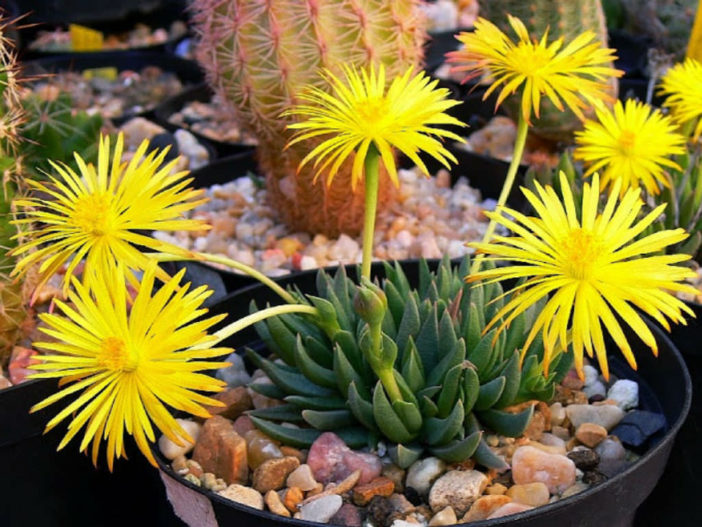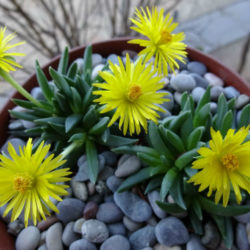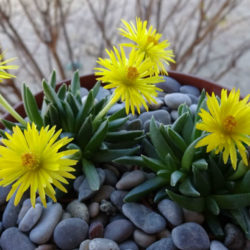Scientific Name
Bergeranthus vespertinus (Berger) Schwantes
Synonym(s)
Bergeranthus jamesii, Mesembryanthemum vespertinum
Scientific Classification
Family: Aizoaceae
Subfamily: Ruschioideae
Tribe: Ruschieae
Genus: Bergeranthus
Origin
Bergeranthus vespertinus is native to South Africa. It grows under shrubs or in crevices in the Eastern Cape province.
Description
Bergeranthus vespertinus is a small succulent that forms a compact clump of trigonous leaves densely packed in rosettes. It can grow up to 2.4 inches (6 cm) tall and 1 foot (30 cm) wide. Initially erect, the leaves become more or less prostrate as they grow and can reach up to 2.4 inches (6 cm) long, up to 0.25 inches (0.6 cm) wide, and 0.15 inches (0.4 cm) thick, tapering to a point. They are grey-green with some darker spots and somewhat wrinkled.
The flowers are yellow, reach up to 1 inch (2.5 cm) in diameter, and appear on long stalks in summer.

Hardiness
USDA hardiness zone 10a to 11b: from 30 °F (−1.1 °C) to 50 °F (+10 °C).
How to Grow and Care
The basics of Mesemb care are very simple, with free-draining soil, plenty of sun and ventilation, and regular light watering in the right season. Yet the difficulties are endless, trying to adapt to the Mesembs' adaptability and follow their growth habits in your particular conditions.
Mesembs require a loam-based compost with extra drainage material such as horticultural grit or perlite. They all like good light conditions and plenty of ventilation.
Some are relatively cold-hardy and can even survive mild winters outside. Most will survive temperatures down to the freezing point. Some Mesembs begin to grow in the autumn as the temperature drops and the days get shorter.
Because different genera within the Mesemb family have different growing conditions, care must be taken with watering. Some genera will benefit from light spray water to prevent shriveling during their dormant period.
See more at How to Grow and Care for Mesembs.
Links
- Back to genus Bergeranthus
- Succupedia: Browse succulents by Scientific Name, Common Name, Genus, Family, USDA Hardiness Zone, Origin, or cacti by Genus
Photo Gallery
Click on a photo to see a larger version.


